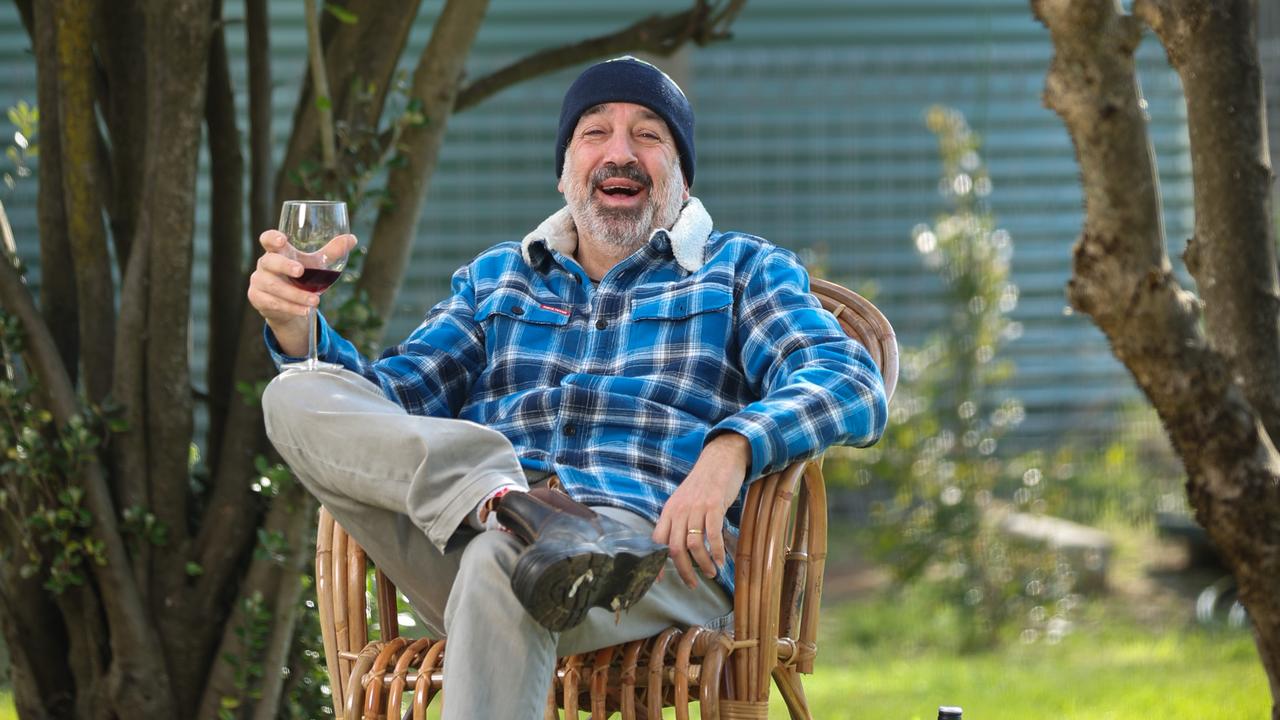Former Supercars driver Karl Reindler finds new passion as Australia’s F1 medical car driver
Karl Reindler knows the extreme danger of being a V8 Supercar driver. He knows what it feels like to be in a car hit at 150km/h. Now, he’s dedicated to revolutionising the sport.
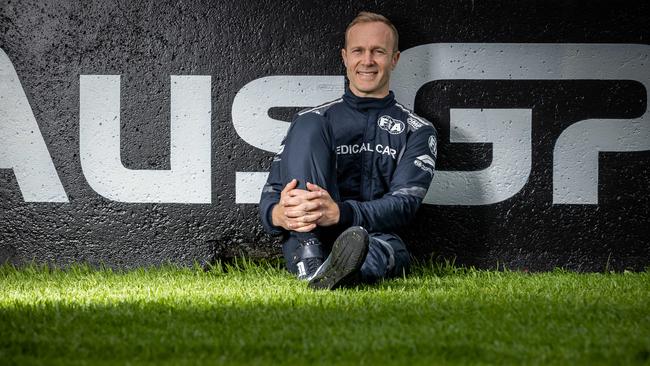
VWeekend
Don't miss out on the headlines from VWeekend. Followed categories will be added to My News.
The Australian racing driver sits in his car awaiting the lights to go out to start the Australian Grand Prix at Albert Park.
The engine is running, the roar of Formula 1 cars surrounds him.
His anticipation and awareness is high.
The first corner of the first lap of any F1 Grand Prix is statistically the most likely to result in a crash.
The lights cycle through their starting sequence and then the mighty F1 cars are away. Verstappen, Hamilton, Leclerc, Alonso, Perez, Russell and Piastri race to the first corner as Australia’s “other” F1 driver, sitting at the rear of the grid, listens intently to race control for any on track incident that will immediately result in a call over the radio, “deploy medical car”.
Former V8 Supercars driver Karl Reindler is at the wheel of the Mercedes AMG with full time FIA F1 Medical Delegate Ian Roberts beside him and a second Australian doctor in the back seat.

If all goes to plan, the trio will sit in the car for the full race length and park it at the end of the day. But as the drivers of the world’s fastest race cars vie for position around the tight Albert Park street circuit, racing wheel to wheel, they know that at any time the call can come, and they must respond at speed.
“We need to be ready to be deployed with a moment’s notice,” Reindler says.
Reindler and the race doctors, in race suits and helmets, are in the car five or 10 minutes before the start of every practice session.
They’ve run through equipment and radio checklists before every session.
They have a direct line of communication to the race director and his team.
“The second they say ‘deploy medical car’, it’s in gear and we are driving out as quickly as we can.”
Reindler knows only too well, better than most, that every second counts.
In 2011 at the Barbagallo racetrack just outside Perth, the Brad Jones Racing driver had qualified 13th on a track he knew very well, having grown up in the Western Australian capital.
But as the race began, Reindler’s clutch failed and he was at the mercy of the half field of drivers behind him as they accelerated down the straight to the first corner.
Video shows cars behind peeling off around him but the driver was unsighted by Steve Owen who ploughed into the back of Reindler’s car at an estimated 150km/h. Reindler’s fuel tank was folded up in the impact and the fuel exploded, creating an instant fireball. “I felt the heat before I saw the fire,” Reindler recalls.
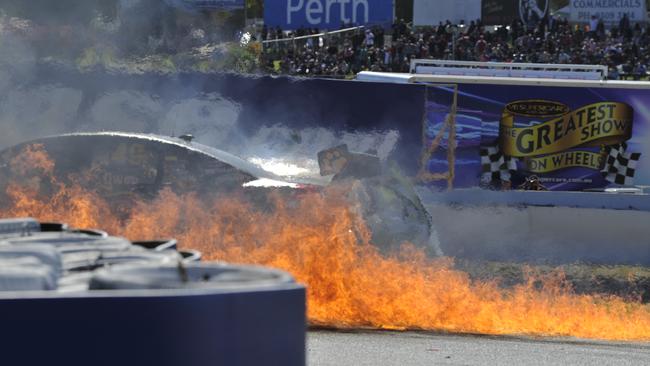
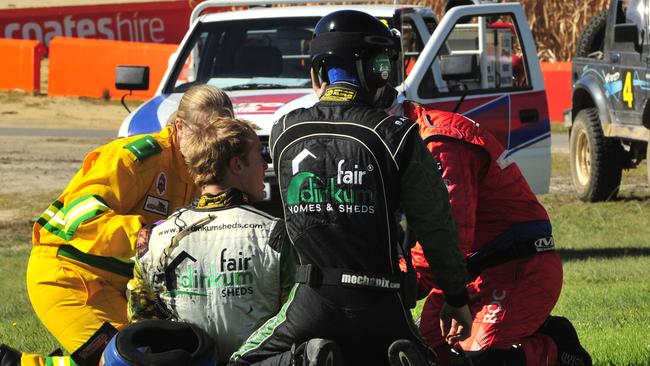

“The heatwave that came through the car was pretty overwhelming.”
It took 17 seconds from impact for Reindler to get out of the car, but it seemed like an eternity as he released tubes from his helmet, undid the 5-point racing harness and window net, all with extremely limited visibility and surrounded by a fuel fire generating temperatures of up to 800 degrees.
One of the first on the scene was a mechanic from Reindler’s pit crew who had jumped the pit lane fence and ran to the driver, forcing him to the ground fearing he may still be on fire.
Reindler had burns to his face, hands and legs and spent some time in a Perth hospital recovering.
The famed WA burns specialist Dr Fiona Wood was one of those taking care of him.
Reindler says the incident had an enduring effect on him and while he continued competing, “my mindset had changed”.
“When you are competing in any sport but particularly a sport with perceived risk, you can’t focus too much on the potential outcome of injury or death.
“You ask any Formula One driver, any Supercars driver, whether they tell you straight up or not, they think nothing’s ever going to happen. They think they’re invincible on the circuit, but the reality is different.

“I like the quote from Ernest Hemingway. He said there’s only three real sports – bull fighting, mountaineering and motor racing. The rest are just games.”
But the safety of this high octane sport has progressed at an equally sharp pace.
“What I love about our sport is that it is continually evolving, changing, adapting,” Reindler says.
“Off the back of my accident was the perfect example. They changed the regulations – they saw (the fuel tank vulnerability) as a problem and decided to shift the fuel cell in front of the axle so it was more robust and better protected.
“There’s always an evolution taking place.
“In Formula One in recent years you’ve seen the introduction of the halo which has potentially saved a lot of lives already in F1, as well as F2 and F3. The key thing about the evolution is that it cascades down all the way from the top Formula, eventually to grassroots motorsport. I love that part of the sport.”
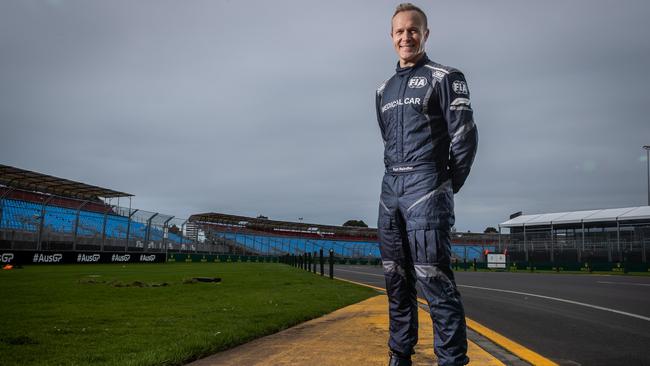
Reindler is one of three children who were introduced to motorsport by their father, who was in mining.
“We had an early interest in motorsport. It was always a treat to stay up late and watch a Grand Prix with dad,” Reindler says. “We just loved it.”
Their father would regularly take the family go-karting, purely as a fun family activity.
“Then you start to take it a little bit more seriously, you are doing more competitions and races and starting to travel around the state. It was a fantastic family sport for us,” Reindler recalls.
“For me there was a passion early on. I absolutely loved the sport but never thought I’d make a career out of it.”
At 19, fresh out of the Formula 3 competition in Australia, Reindler moved to the UK to race in the British Formula 3 series, considered the proving ground for young drivers.
It’s a championship Aussie F1 star Daniel Ricciardo won.
Reindler was then signed to the Australian team in the A1 GP series, with Australian F1 champion Alan Jones overseeing the operation.
After struggling to secure overseas sponsorship, Reindler returned to Australia where he got his first Supercars drive in 2008 at Bathurst.
The call came just 10 days before the race to replace Grant Denyer, who had broken his back in a monster truck accident.
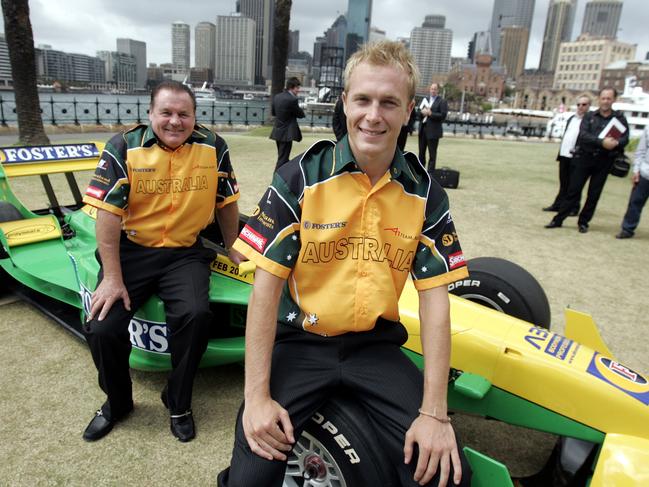
He joined Jason Bright as his endurance race co-driver in 2009, leading to a full time seat with Brad Jones Racing in 2010-11.
In 2012 Reindler joined brothers Rick and Todd Kelly and Supercars legend Greg Murphy at Kelly Racing in what Reindler says was a challenging year as the team prepared to switch to Nissan (from Holden) in 2013 and “dropped the ball” on 2012.
He then drove the endurance races in 2013 before taking 2014 off.
That year Reindler and his wife, Olympic gold medal winning sailor Elise Rechichi welcomed daughter Charlotte, who was born with congenital heart disease. “The focus shifted naturally to family,” Reindler says.
After a year off, Reindler again rejoined Supercars for the endurance races in 2015, at Lucas Dumbrell Motorsport.
“I felt like I’d never driven better in my life off the back of a year off,” Reindler says.
“If there’s one lesson I’ve learned from competing in motorsport, it’s that if you really love something and enjoy it, you’re always going to do a better job at it.
“No matter what I tackle now, it’s firstly if you’re not enjoying it, figure out why. And if you still can’t figure it out, go and find something else to do. And if you really love it, pursue it.”

In 2016-17 Reindler raced with Lee Holdsworth but his work off track was expanding. Around 2012 he had started doing consulting work in the automotive industry, running events, high performance driving programs and coaching.
At an international young driver talent program he met the head of Motorsport Australia and as a result took on the job of high performance and driver development manager with the motorsport governing body.
During this time he would travel overseas to deliver driver safety programs and was introduced to Michael Masi who was Formula One race director from 2019-21.
Reindler had also previously driven against F1 medical car driver Alan van der Merwe and the trio started discussing Reindler sharing the medical car role.
Reindler was to transition into the role at the Australian Grand Prix in 2020 and jumped in the car for a track test at Albert Park on the Wednesday of race week.
He was to fly to Bahrain the next week and do a handover weekend with the intention of doing five or six rounds that year.
“As we all know Friday the 13th of March, 2020, the world changed,” Reindler recalls.

A Covid positive case in the McLaren team saw the race cancelled, and Australia, and the world, faced unprecedented restrictions of movement.
“We all know what happened in Victoria with the lockdowns, and for me I couldn’t travel and I thought the opportunity was lost.”
Masi was replaced by Niels Wittich and at the start of last year the new race boss reached out to Reindler to see if he was still interested.
He now shares the role with Portuguese driver Bruno Correia and drove at seven rounds of the Grand Prix circuit in 2022, including his debut at the Australian Grand Prix.
“Working with the FIA was really interesting. There’s a lot of detail that goes into these weekends, a lot of systems and structures in place and every weekend is unique.
“You’re faced with different challenges at every location you go.
Race week starts with track testing on Wednesday, when Reindler puts his Mercedes-AMG through its paces. He says trust between himself, the two doctors on board and the team in race control is critical.
“You’re driving a car on track as fast as you possibly can. You learn to build strong relationships and rapport very quickly but the trust becomes a critical part of the role, it only works with that trust there. There’s a lot of practice that we do every weekend.”
That includes becoming familiar with the track and the all-important shortcuts through the infield to different sections as time is crucial.
There are also rehearsals for arriving at the medical centre.
“There’s a high level of due diligence that’s required. You do your homework before race weekend, you do a track walk at every circuit we go to and for me it’s not just about what’s the fastest way to get around the circuit but where can I make up time, where can I cut through.”

Albert Park is unique because of the lake in the middle, meaning there’s no cut through from turn nine to the medical centre.
“Literally, every second counts,” Reindler says.
Although fed incident details through the radio, when called out on to the track, Reindler and the doctors will not be sure exactly what they will be faced with.
“You get to the scene of an incident and you’re absorbing everything very quickly and making very accurate decisions,” Reindler says.
“My very first incident was at qualifying at the (2022) Australian Grand Prix. I remember it very clearly. It was turn five – an incident between two cars.
“We were deployed and raced around the track, and as you approached turn five you reduce the pace as you have no idea what to expect.”
“I remember going through turn five and seeing bits of carbon fibre and Formula One bodywork strewn all over the circuit.”
The impact had happened at turn five but the momentum had carried the cars a lot closer to turn six.
The first decisions include where to park to be close enough to assist but to leave room for other vehicles and stay clear of any potential fire, and which driver is most critical.
To assist, telemetry from the race cars is fed to the medical car showing which driver has had the greatest impact.
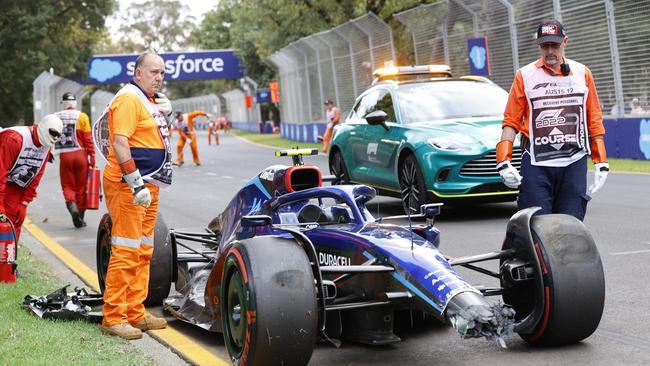
It’s the doctors’ scene, but Reindler will respond to requests to retrieve any of the medical equipment from the car.
He may also be involved in extracting drivers from the car, or overseeing co-ordination at the scene, liaising with race control, managing the vehicles that are arriving and manage the many people at the scene.
Reindler says he and the doctors are conscious that just being in the role exposes them to a level of risk.
But they accept that for the wellbeing of the drivers.
“Generally speaking, the cars are so robust now, most of the drivers are OK.
“We can see that very quickly, we communicate that back to race control, we take the driver in the back with us for a check-up at the medical centre and that’s that. But the reason we are really there is for the more serious incidents, the really critical incidents.
The most serious of those last year was at Silverstone.
“There were three drivers involved but the one that was of most concern was (Chinese driver) Zhou Guanyu. They all ended up being fine but it was a pretty confronting or harrowing moment at first.
“True to form it was lap one, turn one, and to see a car flip in front of you, to see the sparks and the smoke and the debris flying out – that’s why we are there.”
Reindler saw first hand the slick and detailed safety protocols the FIA has instituted to keep both drivers and spectators safe — from the race car’s safety measures to the medical deployment, circuit safety with the catch fencing to stop the car.

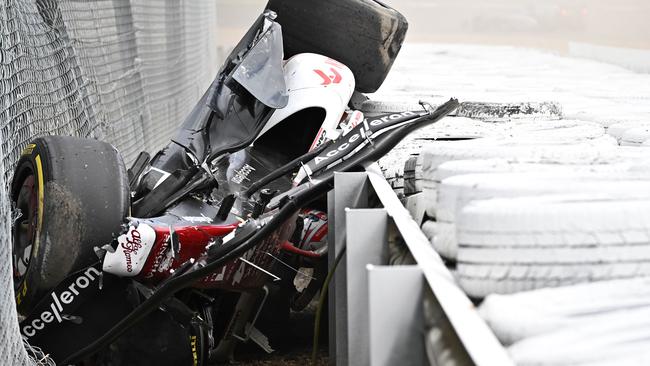
Reindler has lived in Melbourne with Elise and their children Charlotte, 8, and Sebastian, 6, since 2012 and will be extra excited as he drives to his home track this weekend.
He’s raced there before as part of the Supercars and Porsche series, and has had race day roles with Motorsport Australia, but being part of the Big Show is something special.
He recalls having an extra spring in his step last year for his first GP.
“The Wednesday when I rolled in there was a sense of pride. I had my FIA team kit on, knowing I had a really important role to play … it was a really exciting moment for me.
“It feels like a really meaningful role, that we can help and contribute, making the sport better and continue that evolution in safety.
“A lot of time you go under the radar, you sit there, quiet, you are there when you need to be, and most weekends you’re not called to action and it’s once in a blue moon, like at Silverstone, there’s a bigger light that gets shone on the role.
“We always say a boring weekend is a successful weekend for us.”




